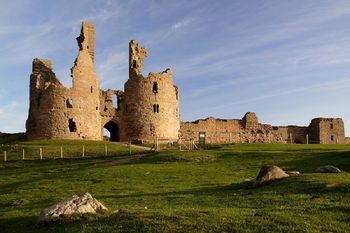Dunstanburgh Castle
Dunstanburgh Castle was founded by the Earl of Lancaster in the early 14th century. The ruins are now open to the public.
History
Dunstanburgh Castle was built in the barony of Embleton on the coast of Northumberland. Thomas, Earl of Lancaster, owned the barony and was a cousin of King Edward II. The barony was only a minor part of Thomas' estates as he also held three earldoms, those of Lancaster, Leicester, and Derby. Thomas and other magnates were jealous of the influence of Piers Gaveston in the royal court, and in 1312 Gaveston was captured at Scarborough Castle, tried, and executed. Thomas and the earl of Warwick were the main instigators of the trail. Edward II pardoned Thomas, but later records show that in May 1313 construction of the castle at Dunstanburgh was already underway, establishing a power base far from the king's centre of influence. Thomas of Lancaster was the second richest secular person in England (only the king was wealthier) and had an income of £11,000 per year. As such building a stone castle at Dunstanburgh would have been an easily absorbed by his finances.[1][2]
In the early 14th-century, England was at war with Scotland, and in June 1314 Edward II suffered a crushing defeat at the battle of Bannockburn. In the aftermath of the battle, Edward II was heavily reliant on his cousin Thomas for the defence of northern England.[3] In 1315, two years after the first mention of construction, Thomas was granted a licence to "crenellate his dwelling-place of Dunstanburgh".[4][5]
The name Dunstanburgh was thought to be a 14th-century creation, emulating the name of nearby Bamburgh Castle however it is now thought that the -burgh suffix may refer to a previous fortification on the site. Archaeological investigations indicated that there was prehistoric or Roman activity on the site of the later castle, possibly an Iron Age promontory fort. By the time Dunstanburgh Castle was built, the area had been used as farmland for several centuries.[6] Dunstanburgh Castle was a statement of power, and would have been visible from Bamburgh Castle, a royal castle 15km away. It has been suggested that Dunstanburgh's architecture was intended to rival the castles built by King Edward I in Wales during the English conquest of the late 13th century (the likes of Caernarfon and Conwy).[7]
In 1321, a group of English barons revolted against Edward II and attacked the lands of his favourites, the Despensers. By March 1322 the rebellion was failing, and it was decided to retreat to Dunstanburgh Castle as Thomas of Lancaster was one of the baronial leaders. En route to the castle Thomas and his army were forced to face the royal army; the earl was captured at the battle of Boroughbridge and executed after a trial. Dunstanburgh Castle then became royal property.[3][8]
Documents from the 16th century show that Dunstanburgh Castle was suffering from neglect.[9]
References
- ↑ Oswald, Alastair; Ashbee, Jeremy; Porteous, Katrina; & Huntley, Jacqui (2006). Dunstanburgh Castle, Northumberland: archaeological, architectural and historical investigations. London: English Heritage. p. 17. ISSN 1749-8775.
- ↑ Oswald, Alastair & Ashbee, Jeremy (2007). Dunstanburgh Castle. London: English Heritage. pp. 25–26. ISBN 978-1-905624-95-9.
- ↑ 3.0 3.1 J. R. Maddicott, ‘Thomas of Lancaster, second earl of Lancaster, second earl of Leicester, and earl of Lincoln (c.1278–1322)’, Oxford Dictionary of National Biography, Oxford University Press, 2004; online edn, Jan 2008 accessed 6 April 2013
- ↑ Davis, Philip (2006–7). "English Licences to Crenellate 1199–1567", The Castle Studies Group Journal vol 20. p. 237.
- ↑ Davis, Philip. "Dunstanburgh Castle licence to crenellate", Gatehouse Gazetteer, accessed 7 April 2013.
- ↑ Oswald & Ashbee, Dunstanburgh Castle, p. 25.
- ↑ Oswald, Ashbee, Porteous & Huntley, Dunstanburgh Castle, Northumberland, pp. 18, 56.
- ↑ Oswald & Ashbee, Dunstanburgh Castle, p. 29.
- ↑ Ashbee, Jeremy, "Research on Dunstanburgh Castle", English Heritage, accessed 6 April 2013.
